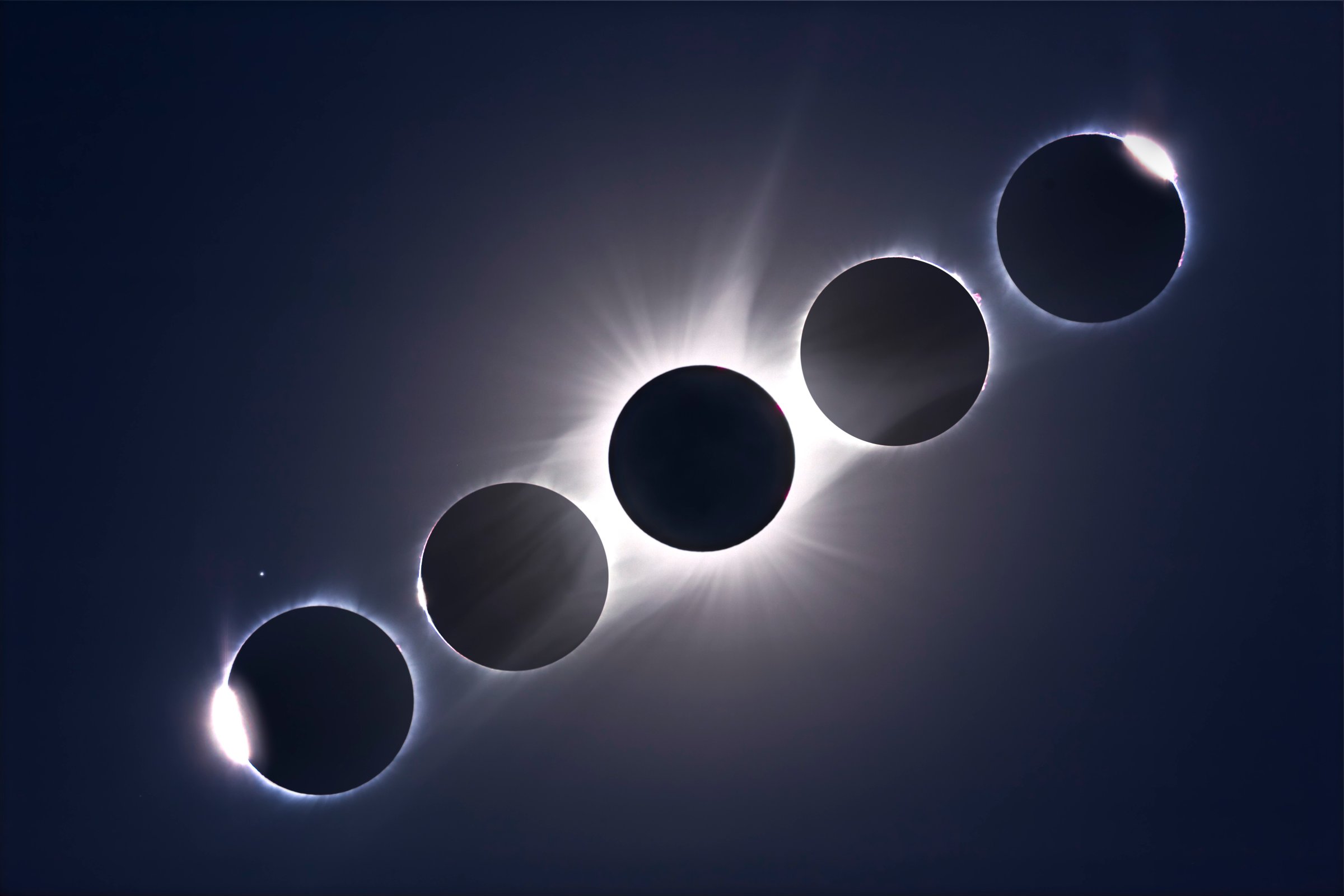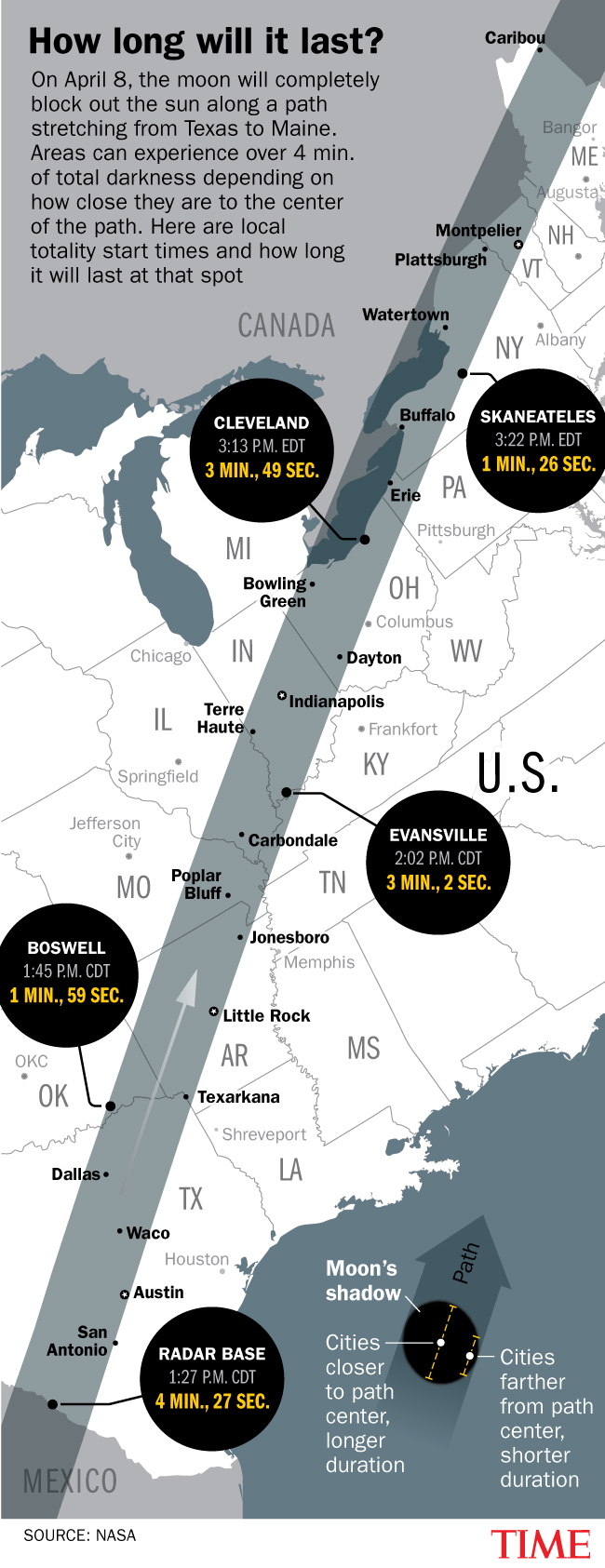
If you’re like all but 74 Americans, you do not live in Radar Base, Texas. Seventy-four is the population of the town, according to the U.S. Census Bureau. Such a tiny place may not be much to your liking, but on April 8, you’ll have cause to envy the people who do live there. That’s because Radar Base will experience four minutes and 27 seconds of totality during the eclipse that will cross the mainland U.S. that day. The celestial spectacle will track from southwestern Texas up through New England in a 185 km (115 mi.) band of totality passing over more than 31 million people. But no other U.S. city will get as much time in the darkness.
Total eclipses are dazzling things, but also exceedingly fleeting things, and just how long they’ll last is very much a function of the Earth’s orbit around the sun, the moon’s orbit around the Earth and where exactly you’re standing on the sphere of our world when the phenomenon is playing out.
Broadly speaking, a total solar eclipse is a function of a bit of cosmic serendipity: the sun is roughly 400 times bigger than the moon, but also 400 times further away, which means that the two disks appear to be about the same size in the sky. When the moon passes in front of the sun, it may thus perfectly and completely block its light, creating a deep black circle, with the fires of the sun—the corona—flaring out in all directions.
But not all eclipses are equal. The moon’s orbit around the Earth is egg-shaped, ranging from a so-called apogee of about 405,000 km (252,000 mi.)—the farthest distance from our planet—to the closer perigee of 360,000 km (224,000 mi.). A moon at or approaching apogee appears too small to block the sun completely, creating what is known as an annular eclipse—one that is less dazzling than a total eclipse since sunlight radiating from around the moon largely blinds us to the sight of the lunar disk. When a total eclipse does occur, viewing it from outside the band of totality results in a similar, less dramatic experience, with the sun appearing as a crescent, obscured only partly by the moon.
Read More: How Animals and Nature React to an Eclipse
Earth’s orbit around the sun is elliptical too, with a maximum distance, or aphelion, of about 152.1 million km (94.5 million mi.), and a minimum distance, or perihelion, of 147.1 million km (91.4 million mi.). At perihelion, the sun appears bigger to us, which can also result in an annular eclipse.
The larger the moon appears in the sky, the longer it takes to pass in front of the sun, making for a more extended period of totality. Where you’re standing within the band of totality matters too: the closer you are to the center of that 185-km strip, the more totality you’ll see.
Any number of websites, including NASA’s, Astronomy.com, and NationalEclipse.com, provide a listing of cities and the times of totality. NASA’s is perhaps the best of a large lot, allowing you to telescope in and click on any city that appears, revealing information not just on the length of totality but on the local time the eclipse moves through its various phases.
Radar Base’s four minute and 27 second period of totality begins at 1:27 p.m. CDT; totality hits Boswell, Okla. at 1:45 p.m. CDT and lasts just one minute and 59 seconds; in Cleveland, it’s three minutes and 49 seconds of totality starting at 3:13 p.m. EDT; in Skaneateles, NY, it’s one minute and 26 seconds, starting at 3:22 p.m. EDT.

There is no shortage of places from which to view the eclipse while it is playing out, and no shortage of events that are planned in both small towns and big cities to mark the moment. There are only two, true verities that will apply that day: no matter where you are during the passage of the eclipse you will, in at least small ways, be transformed; and no matter how many minutes of totality you get, they will never, ever feel like enough.
More Must-Reads from TIME
- Donald Trump Is TIME's 2024 Person of the Year
- Why We Chose Trump as Person of the Year
- Is Intermittent Fasting Good or Bad for You?
- The 100 Must-Read Books of 2024
- The 20 Best Christmas TV Episodes
- Column: If Optimism Feels Ridiculous Now, Try Hope
- The Future of Climate Action Is Trade Policy
- Merle Bombardieri Is Helping People Make the Baby Decision
Write to Jeffrey Kluger at jeffrey.kluger@time.com